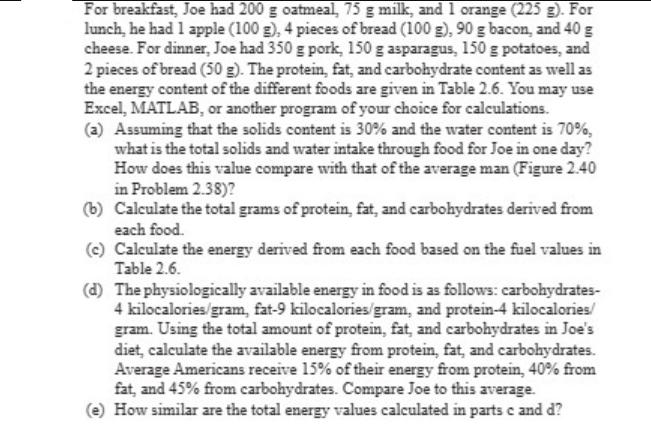Answered step by step
Verified Expert Solution
Question
1 Approved Answer
For breakfast, Joe had 200 g oatmeal, 75 g milk, and 1 orange (225 g). For lunch, he had 1 apple (100 g), 4

For breakfast, Joe had 200 g oatmeal, 75 g milk, and 1 orange (225 g). For lunch, he had 1 apple (100 g), 4 pieces of bread (100 g), 90 g bacon, and 40 g cheese. For dinner, Joe had 350 g pork, 150 g asparagus, 150 g potatoes, and 2 pieces of bread (50 g). The protein, fat, and carbohydrate content as well as the energy content of the different foods are given in Table 2.6. You may use Excel, MATLAB, or another program of your choice for calculations. (a) Assuming that the solids content is 30% and the water content is 70%, what is the total solids and water intake through food for Joe in one day? How does this value compare with that of the average man (Figure 2.40 in Problem 2.38)? (b) Calculate the total grams of protein, fat, and carbohydrates derived from each food. (c) Calculate the energy derived from each food based on the fuel values in Table 2.6. (d) The physiologically available energy in food is as follows: carbohydrates- 4 kilocalories/gram, fat-9 kilocalories/gram, and protein-4 kilocalories/ gram. Using the total amount of protein, fat, and carbohydrates in Joe's diet, calculate the available energy from protein, fat, and carbohydrates. Average Americans receive 15% of their energy from protein, 40% from fat, and 45% from carbohydrates. Compare Joe to this average. (e) How similar are the total energy values calculated in parts c and d?
Step by Step Solution
There are 3 Steps involved in it
Step: 1
Optimization Steps for the Heat Exchanger Network 1 Identify Current current configuration Recognize ...
Get Instant Access to Expert-Tailored Solutions
See step-by-step solutions with expert insights and AI powered tools for academic success
Step: 2

Step: 3

Ace Your Homework with AI
Get the answers you need in no time with our AI-driven, step-by-step assistance
Get Started


